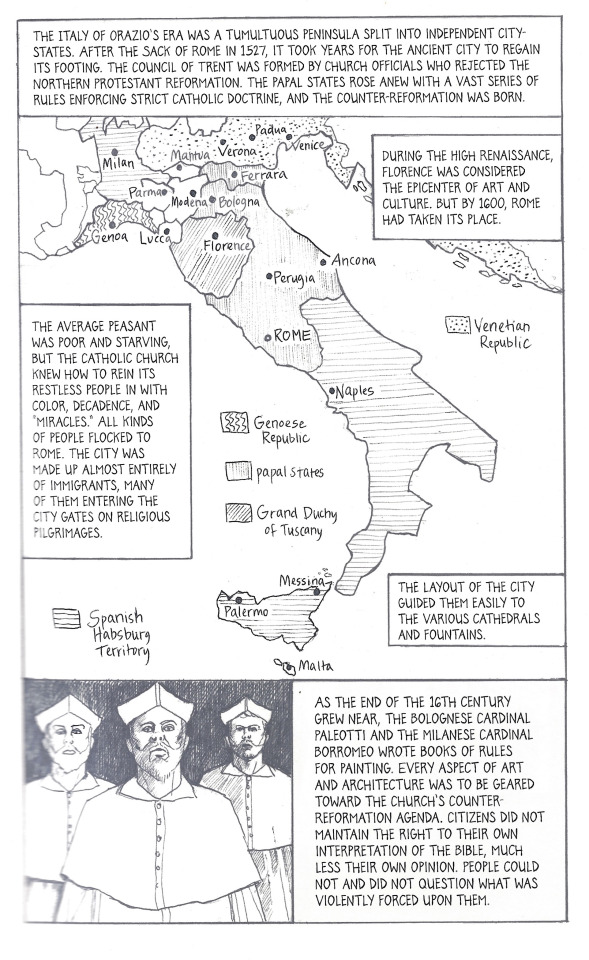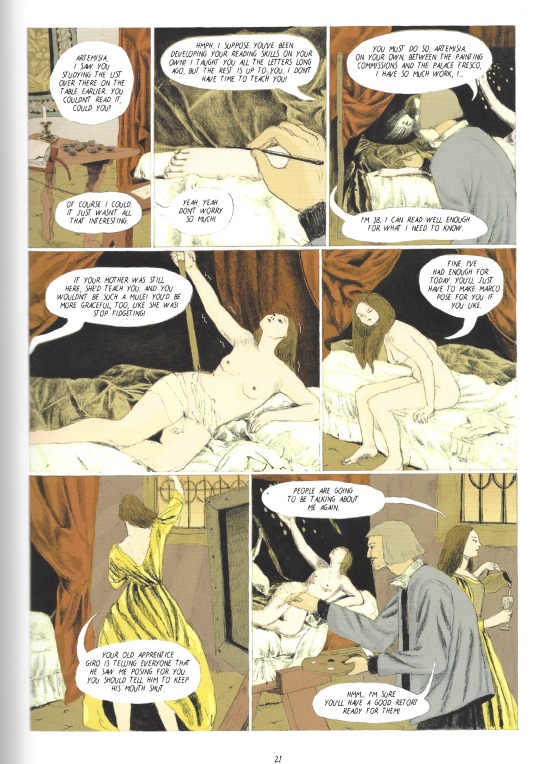#Know What I Am The Life and Times of Artemisia Gentilesch
Text
Comics Read 5/30-6/18/2022
At some time during this pandemic time while I was mostly getting comic books through pre-order where it would be months or longer between purchase an receiving, I started to think of my own collection of comic books, (and for that matter, books and music) as a sort of autobiographical act. The idiosyncrasies of my choices make my collections unique and say a lot about who I am. I am a person in their late thirties who studied art history and attends a lot of museums. Which is why in this entry I am writing about owning two comic book biographies of seventeenth century Italian painter Artemisia Gentileschi, both purchased in the post COVID reality.
These are I Know What I Am The Life and Times of Artemisia Gentileschi by Dina Siciliano and Artemisia with text by Nathalie Ferlut and art by Tamia Baudouin. They could not be more different in style and approach without becoming about different subject matters. I mentioned my age and that I go to museums often to lead to the fact that I did go to the 2001 Metropolitan Museum of Art show Orazio and Artemisia Gentileschi which paired paintings by the father and daughter based on the same Biblical and Classical tales. (Both of these books are more interested in the Biblical than neoclassical paintings.) Siciliano cites the exhibit’s catalogue as one of her sources in the extensive notes section of her book. Ferlut and Baudouin’s book doesn’t have a notes section nor do they list their sources, though they do have some beautiful full color reproductions of Artemisia’s work in the back. Siciliano’s work covers Artemisia’s whole life including rumors about her conception and speculation about her death. (The official cause is unknown, but there was a plague outbreak in Naples around the time she died.) Ferlut and Baudouin’s tale is an intergenerational one of Artemisia’s daughter Prudenzia learning of her mother’s past while Artemisia’s brother, Marco, convinces her to come to London and help their father, Orazio, in his later years, leading to an end of reconciliation.

As you may have guessed from the previous paragraph, Siciliano’s I Know Who I Am is pretty text heavy. At some moments I really appreciate this. My art historical study of Italian art basically ends with the Mannerists, about a generation before Orazio. My knowledge of Italy has huge gaps in areas south of Rome, and as Artemisia spent many of her latter years in Naples I have to appreciate the historic detail she includes. Unfortunately, sometimes the text heavy detail makes it feel like the comic arts medium isn’t right for it. There is a lot to like about the art. Stylistically it draws on intaglio prints of the 17th century. There are great recreations of art discussed. It’s just a little stiff on the page, especially when it is being used to illustrate court transcripts. Periodically there are full page character portraits that have frames helping describe who these historical figures are. One of them is for Galileo, and in comparison to that, one most of the others’ frames are really bare. Which is a good example of the problems of this heavily cited book. In the sections where there is a lack of textual sources on which to rely, it is kind of choppy. I did find myself wondering if maybe building something around emotional truth rather than what can be found to be true. After reading the next book, I decided that for all the ways Siciliano’s book wasn’t a satisfying read, it was still the better choice.

Nathalie Ferlut and Tamia Baudouin’s Artemisia is told with a cruder art style than Siciliano’s and does little to mimic the style and technologies of its subject’s time period. This doesn’t have to be bad. It some ways the figures are less stiff and at one moment there is an interesting play on the fluidity between subject and model, making an interesting comment on how posing for Orazio affected Artemisia.
Both books have to cover Artemisia’s rape by Agostino Tassi, an associate of her father, and it’s aftermath. The aftermath includes both an affair with Tassi (Artemisia thought it would ensure that he would marry her after being “ruined”) to a well documented trial where Tassi was convicted, but never served his (light) sentence. Here the distinctions in storytelling style feel starkest. On the one had I think Artemisia’s depiction of the people around the attack, particularly the (false) family friend Tuzia feels more real. In some ways it seems to care about how it all affected Artemisia as a person more. I Know Who I Am also presents the rape as some result of a conspiracy, which may have some truth to it, but is confusing and does contribute to lessoning Artemisia’s perspective. But its depiction of the affair, while more sexually explicit, may be more responsible by not trying to dramatize it as a power play between Artemisia and Tassi.
The part where I really found myself preferring the I Know Who I Am approach to the material with regards to her marriage and entry to the Academia della Arte. The Siciliano book has Artemisia’s entry into the academy happen early in the marriage with little drama. Ferlut and Baudouin have it late after the marriage disintegrating over her husband’s jealousy of her success and independence. As I saw how much research went into the first of these that I read, I lost my patience with the second around this time.
Making fictionalized biographies is hard, especially when one aspect of the subject’s life is better recorded than anything else.
#what im reading#Comic Books#Graphic novels#Biography#artemisia gentileschi#Know What I Am The Life and Times of Artemisia Gentilesch#Dina Siciliano#Artemisia#Nathalie Ferlut#Tamia Baudouin
0 notes